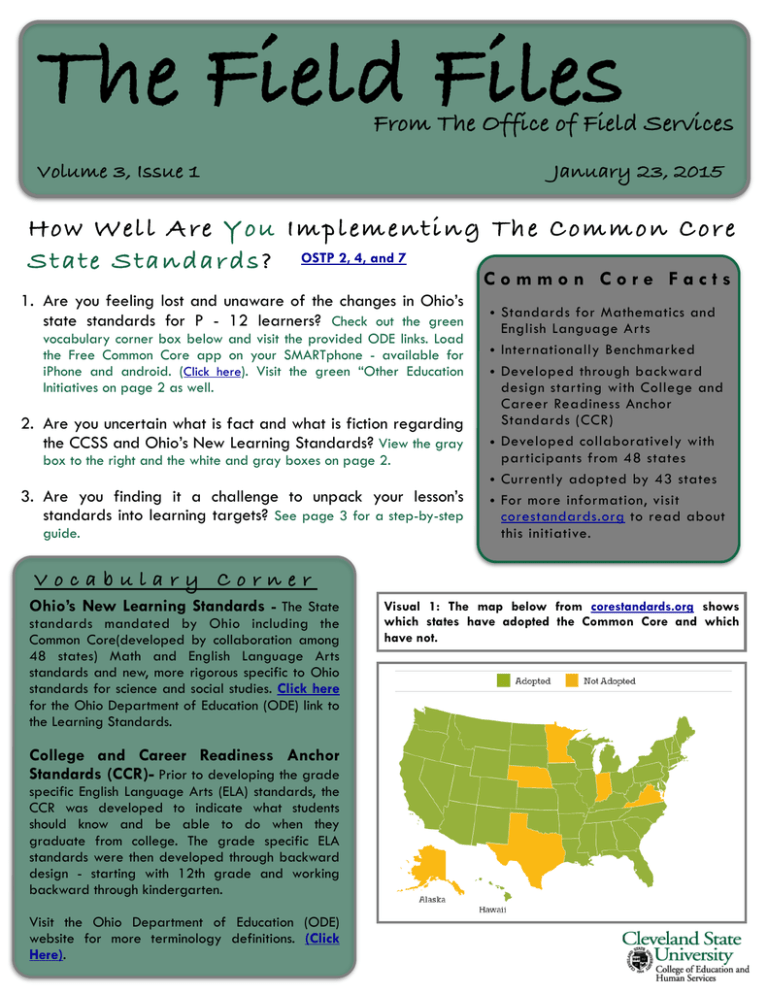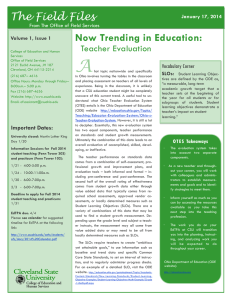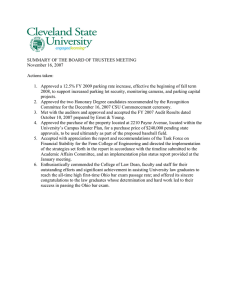The Field Files How Well Are Implementing The Common Core ?
advertisement

The Field Files From The Office of Field Services Volume 3, Issue 1 January 23, 2015 H o w Well Are Y ou Imp le me nt in g T h e Co m mo n C o r e S t a t e S t an dards ? OSTP 2, 4, and 7 Common Core Facts 1. Are you feeling lost and unaware of the changes in Ohio’s state standards for P - 12 learners? Check out the green vocabulary corner box below and visit the provided ODE links. Load the Free Common Core app on your SMARTphone - available for iPhone and android. (Click here). Visit the green “Other Education Initiatives on page 2 as well. ! 2. Are you uncertain what is fact and what is fiction regarding the CCSS and Ohio’s New Learning Standards? View the gray box to the right and the white and gray boxes on page 2. ! 3. Are you finding it a challenge to unpack your lesson’s standards into learning targets? See page 3 for a step-by-step guide. • Standards for Mathematics and English Language Arts • Internationally Benc hmarked • Developed through backward design starting with College and Career Readiness Anc hor Standards (CCR) • Developed collaboratively with participants from 48 states • Currently adopted by 43 states • For more information, visit corestandards.org to read about this initiative. Vocabulary Corner Ohio’s New Learning Standards - The State standards mandated by Ohio including the Common Core(developed by collaboration among 48 states) Math and English Language Arts standards and new, more rigorous specific to Ohio standards for science and social studies. Click here for the Ohio Department of Education (ODE) link to the Learning Standards. ! College and Career Readiness Anchor Standards (CCR)- Prior to developing the grade specific English Language Arts (ELA) standards, the CCR was developed to indicate what students should know and be able to do when they graduate from college. The grade specific ELA standards were then developed through backward design - starting with 12th grade and working backward through kindergarten. ! Visit the Ohio Department of Education (ODE) website for more terminology definitions. (Click Here). Visual 1: The map below from corestandards.org shows which states have adopted the Common Core and which have not. Other Education Initiatives OSTP 7 PA RC C - T h e Pa r t n e r s h i p fo r Assessment of Readiness for College and Careers is a set of assessments aligned to the Common Core State Standards. The PARCC is self defined as a tool to measure whether students are track to be successful in college and their careers. Visit the PARCC website for more information. (Click here). ! ! Impetus for Change in State Standards and Resulting Timeline OSTP 2, 4, and 7 ! Why standardized education across the nation? According to the corestandards.org, most states nationwide began producing their own standards in the 1990s. However, these standards, weren’t standard, and students were receiving vastly different educations from different states as well as being held to varying degrees of expectation depending how much rigor was present in each state. Teacher Evaluation - Teac her evaluation rubrics and processes are not a component of the Common Core and are not common from state-to-state. However, ability to implement the Common Core (along with additional standards specific to each state) is an aspect of teacher evaluations in many states including Ohio. Visit the ODE website for more information on Ohio’s Teacher Evaluation System. (Click here). ! ! Value Added - According to The Ohio Department of Education (ODE) value added is, “A statistical method that helps educators measure the impact schools and teachers have on students’ academic progress rates from year to year.” (click here for more information). This is part of the Student Growth Measures used to evaluate teachers. Visit corestandards.org to read about the development process and the complete timeline for development of the Common Core State Standards. While there, view the 3 minute information packed video. Keep in mind that this website and video are created by the common core state standards initiative. (click here for timeline and video). Common Core Implementation ! ! Pros Cons • Internationally benchmarked standards increase American students’ global competitiveness • Initial resistance to change from teac hers, students, parents, and other stakeholders. • Increased alignment from state-to-state allows for easier comparison of data among states, decrease in cost overtime due to larger pool of resources, and easier transition for students moving from one state to another. • Concern that standardization will decrease individuality and creativity. ! SLOs - Student Learning Objectives are a long-term academic growth target set by a teac her (or in collaboration with other teachers) for student achievement. SLOs are part of the Value-Added Measurement of Teacher Evaluation. ! Ohio Student Learning • Template (click here). • ! • Ohio Student Learning Overview (click here). ! ! Objective Objective Race to the Top - Also known as RttT, Race to the Top was a US Department of Education contest that began in June of 2009. This initiative awarded states points for education reform in specifics areas. For more information click here. ! ! ! • Increased rigor from CCSS will likely decrease need for remedial level courses at college level ! ! ! • Initial increase in cost for new CCSS aligned textbooks and technologies ! • Standards are broad and vague and require unpacking to be useful in the classroom. Unpacking Standards into “ I C a n ” S t a t e m e n t s (OSTP 2 and 4) Unpacking Standards is a complicated process that involves breaking a standard down into student friendly language to create a learning target or “I Can” Statement to be used in a lesson. This process is critical because it allows for evidence that students know what they are expected to know and be able to do at the end of a lesson, and it guides the instructor in creating assessments that measure the day’s learning. Follow this sample process and try to use a standard you are working with in your own classrooms to practice unpacking standards into “I can” statements. 1. Select the standard you are using in planning your lesson. • English Language Arts Standard 3 for Reading for Literature Grade 3 students states, “Describe characters in a story (e.g., their traits, motivations, or feelings) and explain how their actions contribute to the sequence of events. 2. Highlight the verbs in the standard: Describe, explain 3. Identify any academic vocabulary essential to the standard: traits, motivations, sequence of events • Remember that academic vocabulary is the language associated with the learning tasks. Learners need to know what a sequence of events is in order to explain how a character’s actions contribute to it. 4. Break down the standard into individual skills that can be measured. Remember to use student friendly language • I can list qualities of a character. I can describe why individual characters make • the choices they make. I can describe how a character is feeling in a • story. • I can examine how character actions connect to what happens in the story. It would be highly unusual to have 4 “I can” statements in 1 lesson. This would likely be a unit that would span over a time set by you and your mentor teacher or by a district level pacing guide. Important Dates Summer and Fall Practicum and Student Teaching Info Sessions in Fenn Tower 102 * It is mandatory that all students who will be in the field in Summer and Fall 2015 attend 1 session ! Wed 1/28/15 - 5:00 - 6:00pm Fri 1/30/15 - 2:00 - 3:00pm Thurs 2/5/15 - 5:00 - 6:00pm Thurs 2/12/15 - 12:00 - 1:00pm ! Online Application for Summer and Fall Experience Deadline ! Sunday, February 15, 2015 Apply on the OFS website (click here) ! Mandatory edTPA info sessions ! Student Teaching - held in Fenn Tower Room 303 from 2:00 - 4:00 ! Friday, January 30 - 2:00 - 4:00 in Fenn Tower 303 Friday, February 13 - 2:00 - 4:00 in Fenn Tower 303 ! Practicum - all held in Fenn Tower Room 303 from 9:00 - 11:00 a.m. ! Friday, February 13, 2015 Friday, February 27, 2015 Friday, April 17, 2015 ! edTPA Due Date Allow these “I can” statements to guide your planning process and assist you in creation of assessments. Monday, April 6, 2015 Each assessment that you facilitate should measure where your students are in relation to the learning target. Taskstream Submitted to Supervisors: Friday 4/10/15 Have a question about a part of the lesson plan template? Ask your supervisor for guidance and to share the OFS “lesson plan with comments” guide. ! ! Pre-reqs Due to OFS for Summer and Fall May 1, 2015 ! !





